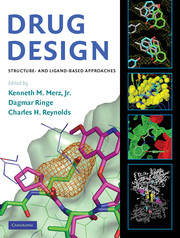Book contents
- Frontmatter
- Contents
- Contributors
- Preface
- DRUG DESIGN
- 1 Progress and issues for computationally guided lead discovery and optimization
- PART I STRUCTURAL BIOLOGY
- PART II COMPUTATIONAL CHEMISTRY METHODOLOGY
- PART III APPLICATIONS TO DRUG DISCOVERY
- 12 Computer-aided drug design: a practical guide to protein-structure-based modeling
- 13 Structure-based drug design case study: p38
- 14 Structure-based design of novel P2-P4 macrocyclic inhibitors of hepatitis C NS3/4A protease
- 15 Purine nucleoside phosphorylases as targets for transition-state analog design
- 16 GPCR 3D modeling
- 17 Structure-based design of potent glycogen phosphorylase inhibitors
- Index
- References
12 - Computer-aided drug design: a practical guide to protein-structure-based modeling
from PART III - APPLICATIONS TO DRUG DISCOVERY
Published online by Cambridge University Press: 06 July 2010
- Frontmatter
- Contents
- Contributors
- Preface
- DRUG DESIGN
- 1 Progress and issues for computationally guided lead discovery and optimization
- PART I STRUCTURAL BIOLOGY
- PART II COMPUTATIONAL CHEMISTRY METHODOLOGY
- PART III APPLICATIONS TO DRUG DISCOVERY
- 12 Computer-aided drug design: a practical guide to protein-structure-based modeling
- 13 Structure-based drug design case study: p38
- 14 Structure-based design of novel P2-P4 macrocyclic inhibitors of hepatitis C NS3/4A protease
- 15 Purine nucleoside phosphorylases as targets for transition-state analog design
- 16 GPCR 3D modeling
- 17 Structure-based design of potent glycogen phosphorylase inhibitors
- Index
- References
Summary
INTRODUCTION
The role of computation in drug discovery has grown steadily since the late 1960s. In the early days emphasis was on statistical and extrathermodynamic approaches aimed at quantifying the relationship of chemical structure to biological properties. From these early efforts the field has grown enormously as evidenced by the chapters in this book. In addition, recent computational approaches place a greater focus on the three-dimensional structure of the ligand and/or protein. Modeling has become a critical tool in the drug discovery process.
The growth in protein-structure-based approaches has mirrored the exponential growth in available protein structures, as evidenced by the number of structures deposited in the Research Collaboratory for Structural Bioinformatics (RCSB). Whereas in the late 1980s only a few protein structures were available, we now have tens of thousands across many classes of therapeutically relevant proteins. This trend shows no sign of abating. To the contrary, new target classes that have been resistant to structure determination are beginning to become available, including G-protein-coupled receptors (GPCRs) and ion channels. This wealth of structures provides a good starting point for modeling protein/ligand interactions, and the application of computer models to identify improved ligands for these targets (Figure 12.1).
CHALLENGES
There are many obstacles that stand in the way of successful modeling of protein/ligand interactions. First is the high degree of computational accuracy required to predict significant changes in binding affinity.
- Type
- Chapter
- Information
- Drug DesignStructure- and Ligand-Based Approaches, pp. 181 - 196Publisher: Cambridge University PressPrint publication year: 2010
References
- 1
- Cited by



